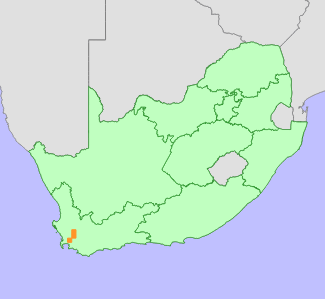|
Scientific Name | Metalasia schlechteri L.Bolus |
Higher Classification | Dicotyledons |
Family | ASTERACEAE |
Synonyms | Planea schlechteri (L.Bolus) P.O.Karis |
National Status |
Status and Criteria | Critically Endangered B1ab(iii,v)+2ab(iii,v); C2a(ii) |
Assessment Date | 2013/01/28 |
Assessor(s) | L. von Staden & H. Stummer |
Justification | A single, small subpopulation of around 200 mature individuals within a 42 ha fragment is threatened by ongoing habitat degradation as well as competition from alien invasive plants. |
Distribution |
Endemism | South African endemic |
Provincial distribution | Western Cape |
Range | Paarl to Klapmuts. |
Habitat and Ecology |
Major system | Terrestrial |
Major habitats | Swartland Granite Renosterveld, Boland Granite Fynbos, Swartland Alluvium Fynbos |
Description | Seasonally waterlogged, gravelly granite derived clay. |
Threats |
| Habitat loss to vineyards and timber plantations is likely to have caused the local extinction of a subpopulation recorded on the lower slopes of the Limietberg Mountains below Bain's Kloof, while urban expansion, infrastructure development and quarrying is likely to have caused the loss of a subpopulation recorded near Klapmuts Station in 1935. Less than 10% of lowland granitic fynbos and renosterveld remain within this species' known range. The only remaining subpopulation occurs within a small protected fragment, but is threatened by competition from alien invasive grasses as well as fertilizer and herbicide runoff from surrounding agricultural lands. |
Population |
This extremely rare and range-restricted species (historical EOO 65 km²) was previously known from only two collections, one made in 1897, and the other in 1935, both from areas now transformed, and was thought to be extinct. However, in 2012, this species was rediscovered by volunteers of the Custodians of Rare and Endangered Wildflowers (CREW) programme in the well-surveyed Briers Louw Nature Reserve. This species flowers in February, well outside the peak fynbos flowering season, and may well be overlooked in lowland granitic sites between Paarl and Klapmuts, although very little natural vegetation remains. This species is currently known from a single small subpopulation of around 200 mature individuals.
|
Population trend | Decreasing |
Assessment History |
Taxon assessed |
Status and Criteria |
Citation/Red List version | | Metalasia schlechteri L.Bolus | CR B1ab(iii,v)+2ab(iii,v); C2a(ii) | 2015.1 | | Planea schlechteri (L.Bolus) P.O.Karis | Critically Endangered (Possibly Extinct) | 2012.1 | | Planea schlechteri (L.Bolus) P.O.Karis | Critically Endangered (Possibly Extinct) | Raimondo et al. (2009) | | Planea schlechteri (L.Bolus) P.O.Karis | Insufficiently Known | Hilton-Taylor (1996) | | Metalasia schlechteri L.Bolus | Uncertain | Hall et al. (1980) | |
Bibliography |
Bengtson, A., Anderberg, A.A. and Karis, P.O. 2011. Phylogeny and generic delimitation of the Metalasia clade (Asteraceae-Gnaphalieae). International Journal of Plant Sciences 172(8):1067-1075.
Goldblatt, P. and Manning, J.C. 2000. Cape Plants: A conspectus of the Cape Flora of South Africa. Strelitzia 9. National Botanical Institute, Cape Town.
Hall, A.V., De Winter, M., De Winter, B. and Van Oosterhout, S.A.M. 1980. Threatened plants of southern Africa. South African National Scienctific Programmes Report 45. CSIR, Pretoria.
Hilton-Taylor, C. 1996. Red data list of southern African plants. Strelitzia 4. South African National Botanical Institute, Pretoria.
Karis, P.O. 1990. Three new genera of the Asteraceae-Gnaphalieae from the Cape region. Botanical Journal of the Linnean Society 102:23-36.
Raimondo, D., von Staden, L., Foden, W., Victor, J.E., Helme, N.A., Turner, R.C., Kamundi, D.A. and Manyama, P.A. 2009. Red List of South African Plants. Strelitzia 25. South African National Biodiversity Institute, Pretoria.
|
Citation |
| von Staden, L. & Stummer, H. 2013. Metalasia schlechteri L.Bolus. National Assessment: Red List of South African Plants version 2024.1. Accessed on 2025/12/24 |
 Comment on this assessment
Comment on this assessment


